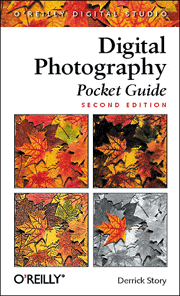Review: Digital Photography Pocket Guide, 2nd ed. (book)
Overview
This book is intended for anyone who owns, or is planning to buy, a digital camera. For novices, it explains in clear concise language the parts of a camera, and each part’s respective function. For experienced photographers, it goes in depth, using terms familiar to anyone experience in film photography, and thus helping complete the transition to digital media. And for everyone, it is truly a “pocket guide,” measuring only 7" X 4 1/4".

Organization
The book is divided into three chapters:
The first chapter, “What is it?” is an alphabetical guide to all the parts of a digital camera. Features are divided into three categories: basic features, those found on all cameras; intermediate features, those useful to people with previous photography experience, or those hoping to advance their skill level; and advanced features, those of interest to experienced photographers looking for the most versatile camera. The individual entries are marked by letter (B for basic, I for intermediate, and A for advanced). This way, each individual can quickly find the entries relevant to his or her camera. In addition, for someone who’s camera shopping, a clear listing of camera features at each level is essential. In my case, having received a review copy prior to purchasing a camera, this book confirmed that the camera I was considering was an intermediate level model, and was priced competitively with other comparable cameras.
The second chapter, “What Does it Do?” describes the practical applications of all the parts and functions covered in the first chapter. Topics are again listed alphabetically, essential in a well-organized reference book, and range from the practical (i.e. Digital vs. Optical Zoom, File Compression) to the technical (i.e. aperture value, exposure metering) to the aesthetic (i.e. composition, close-ups). The language is carefully crafted to be easily understood by the novice shutterbug, while experienced photographers will appreciate the use of familiar terms (i.e. f-stop, shutter speed).
The third chapter, “How Do I …” brings the information in the first two chapters to bear on a number of common photography situations. Though not every instance is covered (or could possibly be covered), the selection of situations are those most likely to compromise a potentially great shot. Outdoor photography, existing-light photography, action shots, architecture shots, and table-top photography are among the common situations covered. Entries cover both technical procedures (i.e. when to use flash, where to place a subject relative to the sun) and aesthetic issues (i.e. where to place the horizon in a shot, taking multiple shots at various distances). Again, the language is clear, concise, and always to the point. I expect this to be the most valuable, and most oft-referred to chapter, of this book.
Other Features
The book features excellent photographic examples throughout, and, most importantly, all of them (except for a single example illustrating sepia tone vs. black and white) are in color. One thing I’ve never been able to understand is books on photography and photo editing software printed entirely in black and white. Of course, it’s cheaper, but an example explaining some aspect of color photography should be in color.
The book also features “Pro Tips” and “Practical Examples” throughout. These are set off from the main text, but always provide information relevant to the topic at hand. For example, in the section on self-portraits (in Chapter 3), the pro tip suggests to “position a mirror behind the camera so that you can better pose yourself at the moment of exposure.” Simple, and seemingly obvious once one reads it, yet how many of us would think of that ahead of time on our own?
The Bottom Line
The preface of this book is titled “Who’s in Charge?” In other words, who decides what the photos will look like, the photographer or the camera. Auto-settings are fine for point and shoot, but those who want to take their photography to the next level will greatly value all the information contained in this book. And it’s small enough to fit in a pocket or a camera bag. What more could you want?

Reader Comments (0)
Add A Comment